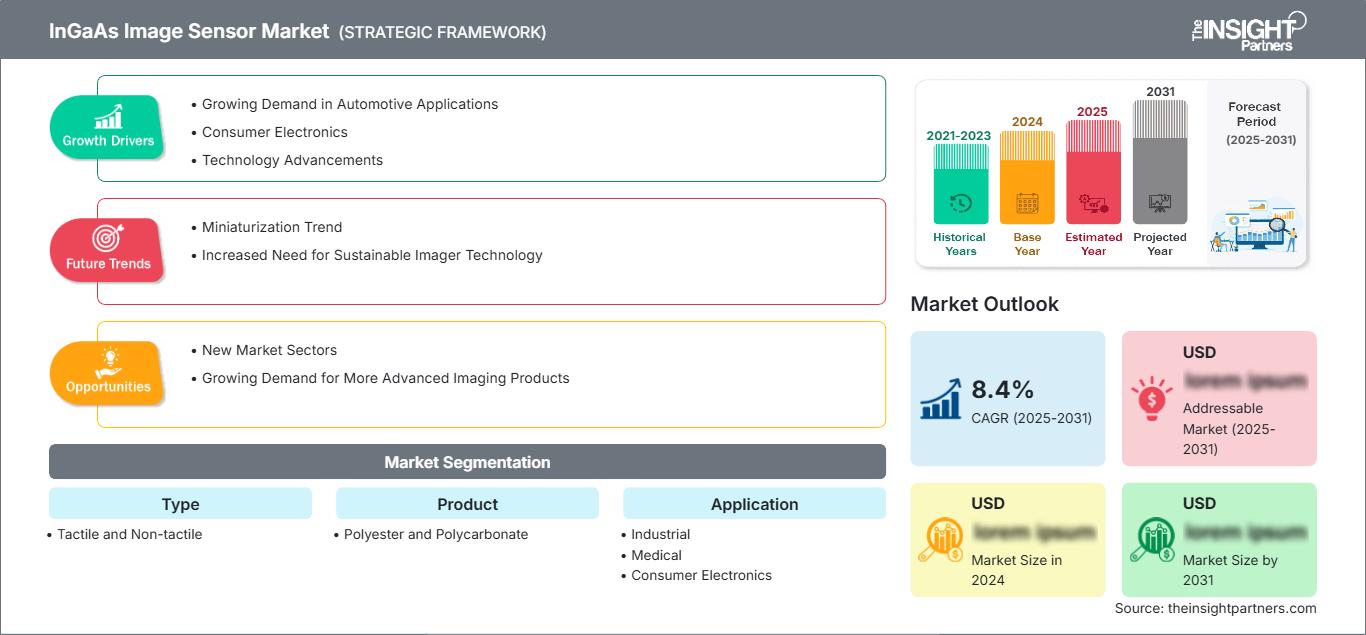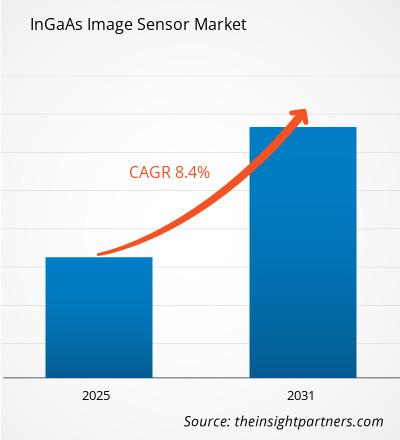Der Markt für InGaAs-Bildsensoren wird voraussichtlich zwischen 2025 und 2031 eine durchschnittliche jährliche Wachstumsrate (CAGR) von 8,4 % verzeichnen, wobei die Marktgröße von XX Millionen US-Dollar im Jahr 2024 auf XX Millionen US-Dollar im Jahr 2031 anwachsen wird.
Der Bericht ist nach Typ (taktil und nicht taktil), Produkt (Polyester und Polycarbonat) und Anwendung (Industrie-, Medizin- und Unterhaltungselektronik) segmentiert. Die globale Analyse ist weiter nach Regionen und wichtigen Ländern aufgeschlüsselt. Der Bericht bietet den Wert in USD für die obige Analyse und Segmente.
Zweck des Berichts
Der Bericht „InGaAs-Bildsensormarkt“ von The Insight Partners zielt darauf ab, die aktuelle Situation und das zukünftige Wachstum sowie die wichtigsten treibenden Faktoren, Herausforderungen und Chancen zu beschreiben. Dadurch erhalten verschiedene Geschäftsinteressenten Einblicke, beispielsweise:
- Technologieanbieter/-hersteller: Um die sich entwickelnde Marktdynamik zu verstehen und die potenziellen Wachstumschancen zu kennen, sodass sie fundierte strategische Entscheidungen treffen können.
- Investoren: Um eine umfassende Trendanalyse hinsichtlich der Marktwachstumsrate, der finanziellen Marktprognosen und der Chancen entlang der Wertschöpfungskette durchzuführen.
- Regulierungsbehörden: Um Richtlinien und Überwachungsaktivitäten auf dem Markt zu regulieren, mit dem Ziel, Missbrauch zu minimieren, das Vertrauen der Investoren zu wahren und die Integrität und Stabilität des Marktes aufrechtzuerhalten.
InGaAs-Bildsensor-Marktsegmentierungstyp
- Taktil und nicht-taktil
Produkt
- Polyester und Polycarbonat
Anwendung
- Industrie
- Medizin
- Unterhaltungselektronik
Geografie
- Nordamerika
- Europa
- Asien-Pazifik
- Naher Osten und Afrika
- Süd- und Mittelamerika
Sie erhalten kostenlos Anpassungen an jedem Bericht, einschließlich Teilen dieses Berichts oder einer Analyse auf Länderebene, eines Excel-Datenpakets sowie tolle Angebote und Rabatte für Start-ups und Universitäten.
Markt für InGaAs-Bildsensoren: Strategische Einblicke

-
Holen Sie sich die wichtigsten Markttrends aus diesem Bericht.Dieses KOSTENLOSE Beispiel umfasst Datenanalysen, die von Markttrends bis hin zu Schätzungen und Prognosen reichen.
Wachstumstreiber für InGaAs-Bildsensoren
- Steigende Nachfrage im Automobilbereich: InGaAs-Bildsensoren werden in Fahrerassistenzsystemen in Fahrzeugen eingesetzt, um die Sicherheit zu verbessern und autonomes Fahren zu ermöglichen. Das Marktwachstum ist enorm, da Hersteller überlegene Bildgebungslösungen für eine bessere Fahrzeugleistung benötigen.
- Unterhaltungselektronik: Die Nachfrage nach leistungsstarken Bildgebungslösungen in der Unterhaltungselektronik ist ein wichtiger Treiber. Durch die Integration des InGaAs-Sensors in Smartphones, Kameras und andere elektronische Geräte entstehen in der Unterhaltungselektronik hochwertigere Produkte, die die Geräteanforderungen nach qualitativ hochwertigerer Bildgebung besser erfüllen können, was zu einer Expansion des Marktes führt.
- Technologische Fortschritte: Technologische Fortschritte, wie beispielsweise der CMOS-Bildsensor, haben den Markt für InGaAs-Bildsensoren maßgeblich beflügelt. Diese ermöglichen eine einfachere Signalverarbeitung und allgemein eine bessere Leistung in Bildgebungssystemen, was zu einer zunehmenden Nachfrage nach Anwendungen in verschiedenen Industriezweigen führt.
Zukünftige Trends im Markt für InGaAs-Bildsensoren
- Trend zur Miniaturisierung: Ein interessanter Aspekt ist die Miniaturisierung von InGaAs-Bildsensoren, um sie in kompaktere Geräte einzubauen, ohne Kompromisse bei der Qualität einzugehen. Die Technologie gewinnt in der Unterhaltungselektronik und bei tragbaren Geräten an Bedeutung.
- Erhöhter Bedarf an nachhaltiger Bildsensortechnologie: Bei Bildsensoren besteht ein zunehmendes Interesse an nachhaltiger Technologie. Die Unternehmen werden ein zunehmendes Interesse an InGaAs-Sensoren mit umweltfreundlichem Design feststellen, die entwickelt wurden, um Nachhaltigkeitsziele auf der ganzen Welt zu erfüllen und umweltbewusste Kunden anzuziehen.
Marktchancen für InGaAs-Bildsensoren
- Neue Marktsektoren: Mit InGaAs-Bildsensoren bieten neue Märkte in den Bereichen Gesundheitswesen und Verteidigung einige bedeutende Chancen. Diese Sensoren werden unter anderem in der medizinischen Bildgebung und Überwachung eingesetzt und weisen hohe Wachstumsraten auf.
- Steigende Nachfrage nach fortschrittlicheren Bildgebungsprodukten: Die hohe Bildqualität in vielen Bereichen wie der industriellen Automatisierung und Sicherheit bietet große Chancen. Wo Industrien nach hochentwickelter Bildgebungstechnologie suchen, wird der Markt für InGaAs-Bildsensoren ein enormes Wachstum verzeichnen.
Regionale Einblicke in den Markt für InGaAs-Bildsensoren
Die Analysten von The Insight Partners haben die regionalen Trends und Faktoren, die den Markt für InGaAs-Bildsensoren im Prognosezeitraum beeinflussen, ausführlich erläutert. In diesem Abschnitt werden auch die Marktsegmente und die geografische Lage von InGaAs-Bildsensoren in Nordamerika, Europa, im asiatisch-pazifischen Raum, im Nahen Osten und Afrika sowie in Süd- und Mittelamerika erläutert.
Umfang des Marktberichts zum InGaAs-Bildsensor
| Berichtsattribut | Einzelheiten |
|---|---|
| Marktgröße in 2024 | US$ XX million |
| Marktgröße nach 2031 | US$ XX Million |
| Globale CAGR (2025 - 2031) | 8.4% |
| Historische Daten | 2021-2023 |
| Prognosezeitraum | 2025-2031 |
| Abgedeckte Segmente |
By Typ
|
| Abgedeckte Regionen und Länder |
Nordamerika
|
| Marktführer und wichtige Unternehmensprofile |
|
Dichte der Marktteilnehmer für InGaAs-Bildsensoren: Auswirkungen auf die Geschäftsdynamik verstehen
Der Markt für InGaAs-Bildsensoren wächst rasant. Dies wird durch die steigende Endverbrauchernachfrage aufgrund veränderter Verbraucherpräferenzen, technologischer Fortschritte und eines stärkeren Bewusstseins für die Produktvorteile vorangetrieben. Mit der steigenden Nachfrage erweitern Unternehmen ihr Angebot, entwickeln Innovationen, um den Bedürfnissen der Verbraucher gerecht zu werden, und nutzen neue Trends, was das Marktwachstum weiter ankurbelt.

- Holen Sie sich die Markt für InGaAs-Bildsensoren Übersicht der wichtigsten Akteure
Wichtige Verkaufsargumente
- Umfassende Abdeckung: Der Bericht analysiert umfassend Produkte, Dienstleistungen, Typen und Endnutzer des InGaAs-Bildsensor-Marktes und bietet einen ganzheitlichen Überblick.
- Expertenanalyse: Der Bericht basiert auf dem umfassenden Verständnis von Branchenexperten und Analysten.
- Aktuelle Informationen: Der Bericht gewährleistet Geschäftsrelevanz durch die Berichterstattung über aktuelle Informationen und Datentrends.
- Anpassungsoptionen: Dieser Bericht kann an spezifische Kundenanforderungen angepasst werden und passt sich optimal an die Geschäftsstrategien an.
Der Forschungsbericht zum InGaAs-Bildsensor-Markt kann daher dazu beitragen, die Branchensituation und die Wachstumsaussichten zu entschlüsseln und zu verstehen. Obwohl es einige berechtigte Bedenken geben mag, überwiegen die Vorteile dieses Berichts tendenziell die Nachteile.
- Historische Analyse (2 Jahre), Basisjahr, Prognose (7 Jahre) mit CAGR
- PEST- und SWOT-Analyse
- Marktgröße Wert/Volumen – Global, Regional, Land
- Branchen- und Wettbewerbslandschaft
- Excel-Datensatz
Aktuelle Berichte
Verwandte Berichte
Erfahrungsberichte
Grund zum Kauf
- Fundierte Entscheidungsfindung
- Marktdynamik verstehen
- Wettbewerbsanalyse
- Kundeneinblicke
- Marktprognosen
- Risikominimierung
- Strategische Planung
- Investitionsbegründung
- Identifizierung neuer Märkte
- Verbesserung von Marketingstrategien
- Steigerung der Betriebseffizienz
- Anpassung an regulatorische Trends






















 Kostenlose Probe anfordern für - Markt für InGaAs-Bildsensoren
Kostenlose Probe anfordern für - Markt für InGaAs-Bildsensoren